In 2021, LEGO released the bold and vibrant 40516 Everyone is Awesome set—a buildable display with rainbow minifigures in the colors of the gay pride and transgender flags to celebrate the LGBTQ+ community. The minifigures were not only a boon to the AFOL community who wanted solid-color figs, but the set was an expression of hope and joy for a group of people who needed to hear it. The set unapologetically sent the message, “Whoever you are and however you identify, you are awesome and welcome in the LEGO community.”

It marked a shift. Long seen as a champion of creativity and play, LEGO rarely took public stances on social issues. But with this set, the company visibly aligned itself with values of visibility, diversity, and acceptance. Fans responded with a flood of gratitude, emotion, and pride. I remember tearing up after purchasing the set on opening day, having to drive more than an hour to do so. For the first time, I saw myself in a LEGO set exactly as I was, without any wink or nod—no customization needed. LEGO followed up with events, art galleries, and even hosted information on their official webpage about the LGBTQ+ AFOL community.

“The starting point for this was my feeling that we, as a society, could be doing more to show support for each other and appreciate our differences.” – Matthew Ashton, Vice President of Design
But a lot can change in four years. Today’s political climate for companies is challenging, and I suspect that rolling out a new set for Pride month would be met with more resistance than the company wants to deal with. Enter LEGO Art. Art is subjective. Art is evocative. Art can mean something different to anyone who sees the same piece hanging on the wall.
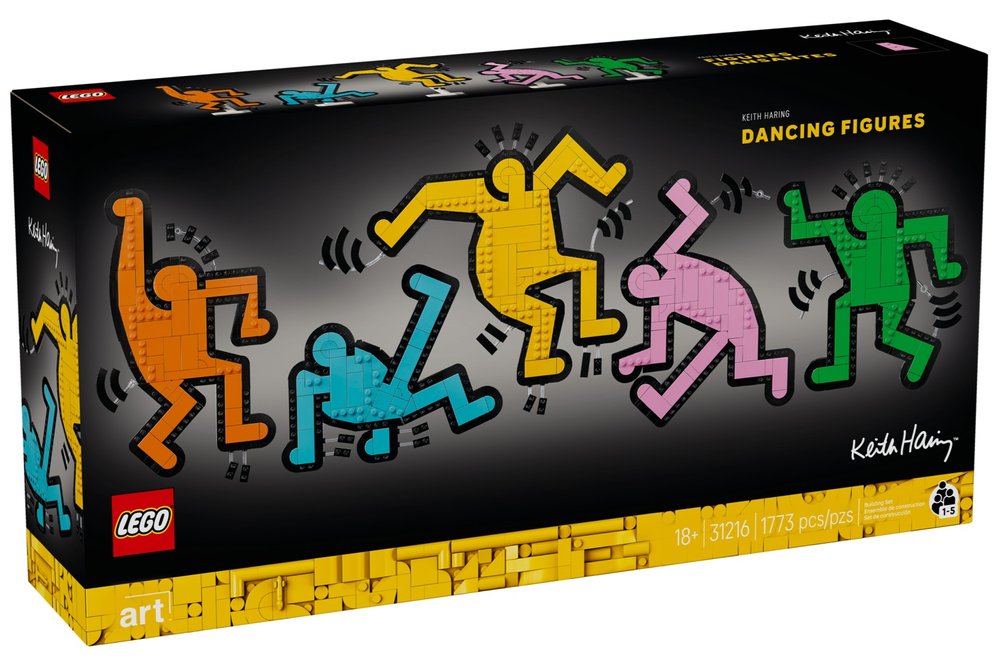
And it is through LEGO Art that the company is releasing a new set echoing that original message of celebrating diversity—31216 Keith Haring Dancing Figures. The set is a celebration of movement and inclusion. Its bold lines and bouncing forms bring Haring’s iconic kinetic figures to life. And for those who know what to look for and what Haring stood for, the message is clear: Everyone is still awesome.
The Meaning of Dancing Figures
Keith Haring’s dancing figures are among the most recognizable images in contemporary art. They are deceptively simple yet radiate movement and a sense of community. With thick black lines and vibrant colors, the figures are never alone. They twist, lean, dance and jump in relation to each other. All of his figures lack facial features and detailed anatomy (in most cases), yet they convey intense emotion through posture alone: knees bent in joy, arms lifted in resistance, and bodies leaning toward each other as they dance.

More than just visual motifs, these figures are part of a coded vocabulary Haring developed, meant to bypass institutional barriers and speak directly to the people. He was a sort of NYC Banksy before Banksy ever graffitied his first wall. He wanted to transform normal, everyday environments into celebrations of the people in the community—people who wouldn’t stand still in the face of oppression.

Image via MFAH
This wasn’t accidental. Haring’s joyful aesthetic was deeply political. In a time of rampant homophobia during the AIDS crisis, he offered a counter-message of visibility, movement, and life. His art was a quiet form of resistance, offered with a smile. His figures danced their way into the public imagination and have since been used in every way that pop art can reach the masses through cards, shirts, stamps, and more. (Read my previous BrickNerd article about the power of pop art when we looked at Robert Indiana’s LOVE statue set.)
And this is what LEGO captures so effectively in the Dancing Figures set, reframed yet again in a new medium. The five colorful figures echo Haring’s original poses, surrounded by a bold black outline and motion indicators. When I first saw photos of the set, I almost didn’t believe my eyes since the figures pop so much. The result is a set that not only pays tribute to an artist but channels the very spirit of the work it emulates, released at the perfect moment for quiet resistance and support of a community in need.
Building Static Movement
I have to be honest, I didn’t take many pictures while building the set. I’m sure there will be many other Fan Media sites that document the bags, build process, techniques, and new parts. I was too enthralled by the concept of the set that I wanted to just build. The set comes with five separate instruction books, one for each figure. (Can you say team speed build!?)
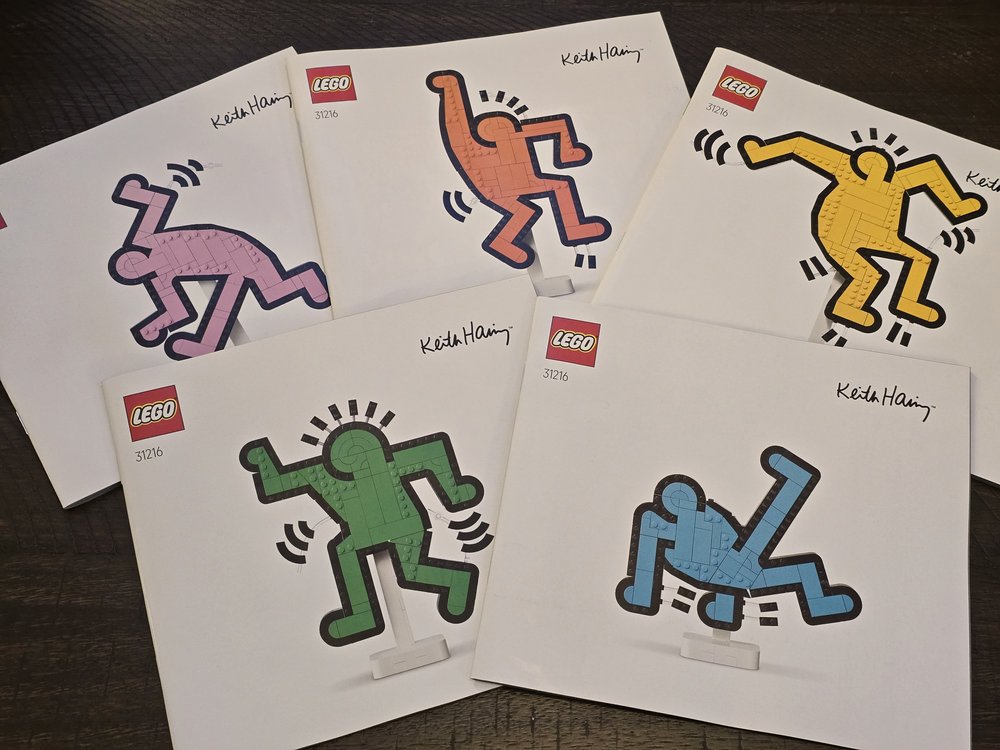
After finishing one figure, I invited my husband over to help build the rest with me. We both sat on the couch and enjoyed the afternoon, chatting about the many clever techniques employed to achieve the geometry of the figures’ poses.





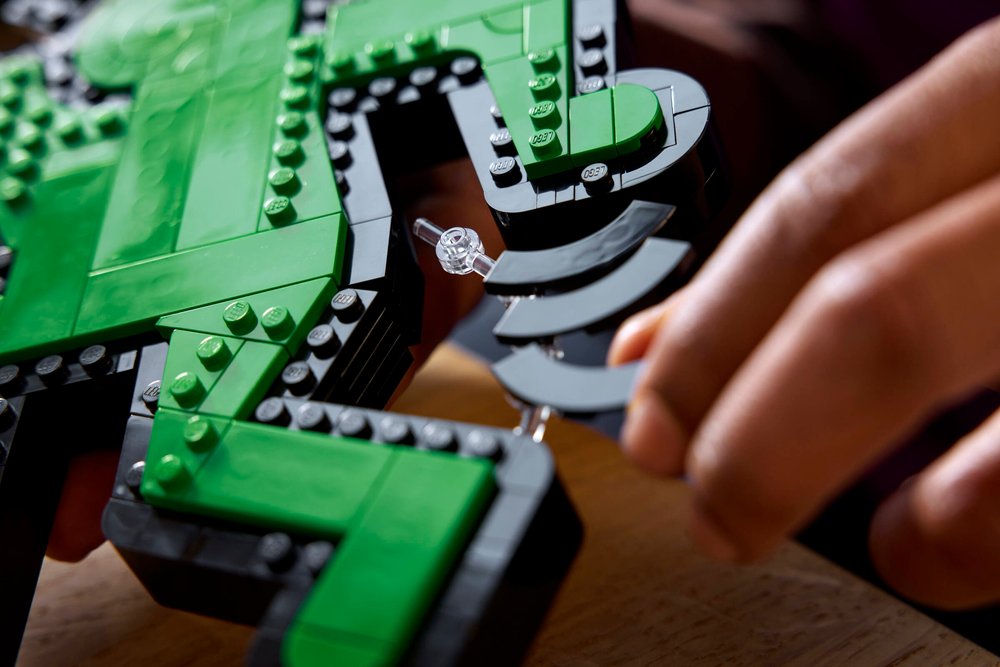
There’s a rhythm to the build process. No two figures are alike, but each one follows the same pattern. You built the core, attach the limbs, add the expressive black motion marks, and then build a white stand so it can be displayed upright. The motion marks are by far the most tedious part to get right—I was adjusting them many times to satisfy my OCD and wanting them to be perfectly positioned.
The set isn’t particularly complex but it does utilize the “five plates to a brick” rule for some clever sideways and SNOT building. A few of the limbs are attached at interesting angles as well, connected with a little LEGO math and some smart use of jumpers and tiles. There is also one tile that utilizes gravity as a technique and is locked into place, not connected to anything. That was fun!
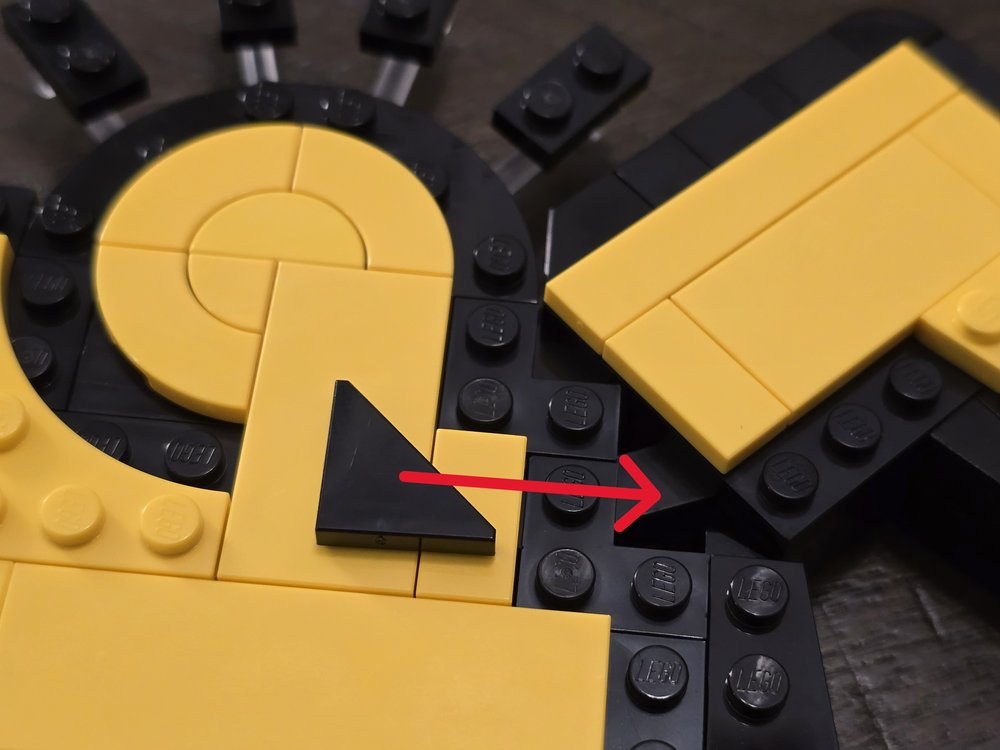
The white bases are both easy to build and cleverly constructed. I have to give kudos to the designer since figuring out all the sweet spots where the weight is balanced could not have been easy. One base is even reinforced since the figure above is a bit asymmetrical.
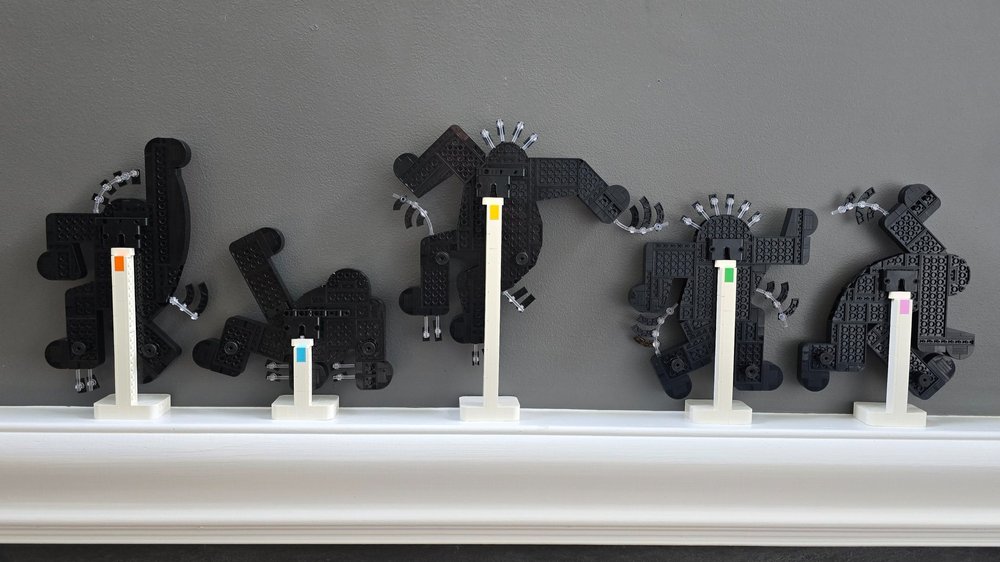
Each figure also has the option to be hung on a wall, though having hung a decent bit of art in my life, getting the perfect positioning with a nail in the wall will not be easy—but the effort will be worth it. However you choose to display them, the illusion of motion remains.

We put them on our mantle. My husband and I just moved into a new home, and it came with a fireplace with a mantle that’s only a few inches thick. We had no idea what to display there… until this set was announced.

The black outlines really make the figures stand out against the wall, and we are thrilled to make the space feel more vibrant. Sometimes I just enjoy looking out the window at the trees or listening to the rain, and the set catches my eye in a new way. Even as a static piece, this set refuses to stand still.

The Artist and the Advocate
Keith Haring wasn’t just an artist. He was a street painter, activist, and advocate who believed art belonged in public spaces and in public service. He rose to fame in 1980s New York City by turning blank subway ad spaces into chalk drawings where people could see it, touch it, and feel part of it. His artwork pops up everywhere from larger than life statues to the Cathedral of St. John the Divine.

Image via Queer Happened Here
Openly gay in an era when coming out carried enormous personal and professional risk, Haring refused to be invisible. His identity was intrinsic to his work, and he saw no reason to separate the political from the personal. When the AIDS crisis began ravaging his community in the 1980s, he didn’t stay silent. He created posters, murals, and public campaigns that educated, warned, and mourned. His “Silence = Death” image remains one of the most powerful visuals of AIDS activism. His work was more than cartoons. They were signs of protest, grief, love, and resilience.
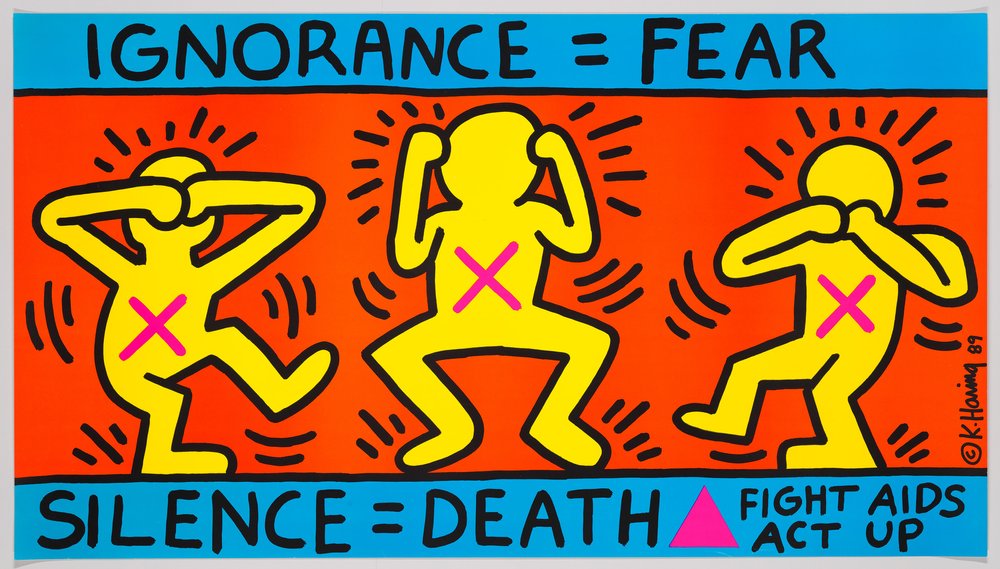
Image via Whitney Museum of American Art
At the same time, he believed in art as a universal language. His signature style of bold black lines and mono-color figures wasn’t just playful. It was disarming. It let people in. It made room for joy even amid tragedy. Whether tackling heavy themes like environmental collapse, drug addiction, or queer liberation, Haring always put the human first in his artwork, no matter where he was working.
He illegally painted the now-famous “Crack Is Wack” mural on a handball court wall in Harlem in 1986. It’s a combination of dancing figures and bold anti-drug messaging that blends activism with art.

image via 6sqft
In 1989, having been diagnosed with AIDS himself, he founded the Keith Haring Foundation. Its mission is to support children’s arts education and continue HIV awareness. He also painted a bathroom in a NYC LGBT center, one of his last dancing figures murals called “Once Upon a Time.” This time, the figures were more expressive as a nod to the sexual freedom he wished for the world and a tribute to a generation that refused to go quietly. (You can see images here, but be warned that they are more targeted to adults.)
He died just nine months later at the age of 31, but his creativity remains painted on the walls of New York. In a world that still grapples with visibility and representation, it is a joy to have this LEGO set as a tribute to Haring’s work and a celebration of diversity and life.
Dancing in the Wild
Of all the places to experience Keith Haring’s art, the one that most closely echoes the Dancing Figures LEGO set isn’t a museum or gallery—it’s a hospital. On a recent trip to New York City, I made my way out to Woodhull Medical Center in Brooklyn, home to one of Haring’s largest and most joyful murals. I’d called ahead to confirm I could visit, though I’m pretty sure the receptionist thought I was crazy for wanting to visit a hospital just to see some artwork. Still, she let me know I was welcome to stop by.

IMage via Hyperallergic
When I arrived, the lobby was quiet. A few patients sat waiting, staff walked by without giving the walls much thought. But to me, the space pulsed with energy. Haring’s kinetic figures danced across the ceiling and down a long corridor, painted in bright primary colors with playful poses, transforming an otherwise unremarkable waiting room into a place full of life.




It somehow felt both out of place and very appropriate for a hospital. Some people didn’t even notice, and one woman asked what I was looking at. I found myself scanning the mural, comparing each painted pose to the ones in the LEGO set to find a match, to no avail. Each figure felt custom-fit to the curves and corners of the wall, dancing precisely where it needed to be.
View fullsize
View fullsize

Images via The Keith Haring Foundation
That sentiment appears to stem from Haring’s original proposal for the mural, which stated that the work should be site-specific and “positive, uplifting, un-aggressive, imaginative, and comforting.” Reading that quote made me think about it from a LEGO perspective. Sometimes I don’t start building with a fixed plan. I just have a feeling or a theme in mind, and then I let the pieces speak to me. I know the general vibe of the MOC I want to build, so perhaps creativity is being in the right space and living in the moment. Haring seemed to know that instinctively.

Image via WSJ
Seeing Haring’s art in person is different. His work wasn’t meant to be confined to frames. It was made for walls, streets, bathrooms and hospitals—places where life happens. That’s what makes the LEGO set so meaningful. It invites you to build, and by doing so, to participate in life, no matter what your belief or orientation.
Quiet Advocacy
I suspect this quiet advocacy is why LEGO is releasing the Keith Haring Dancing Figures set right now. Because of the highly charged and political environment, the company needed a way to celebrate the LGBTQ+ community without saying it out loud. This set doesn’t wear politics on the box. There’s no rainbow banner. No overt Pride messaging. But the signals are there for those who know how to read them.

For example, it is easy to rearrange the figures in rainbow order. And in comparison to the original artwork, the pink color LEGO chose more closely resembles that of the transgender flag. And the very choice to honor Keith Haring—an outspoken queer artist and AIDS activist—is a statement in itself to those who know. This is what quiet advocacy looks like. It doesn’t provoke; it invites. It speaks softly but clearly. In a time when even basic gestures of inclusion can spark backlash, this kind of design-driven messaging can be powerful.
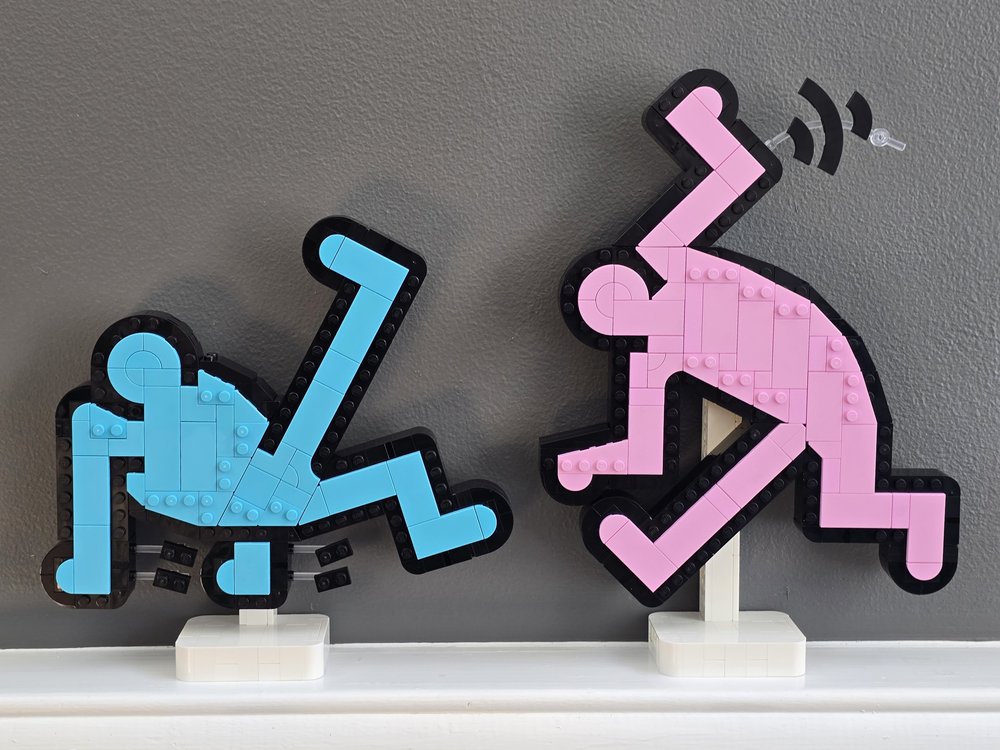
But on the other hand, quiet advocacy can also be ambiguous. It is not lost on me that the instructions barely feature any information about the artist, unlike many other LEGO Art sets that go into more detail. Without clear statements, some fans may argue that my interpretation of the set is incorrect. LEGO’s omission of its many diversity initiatives in its most recent annual report is equally concerning and feels like a step backward.
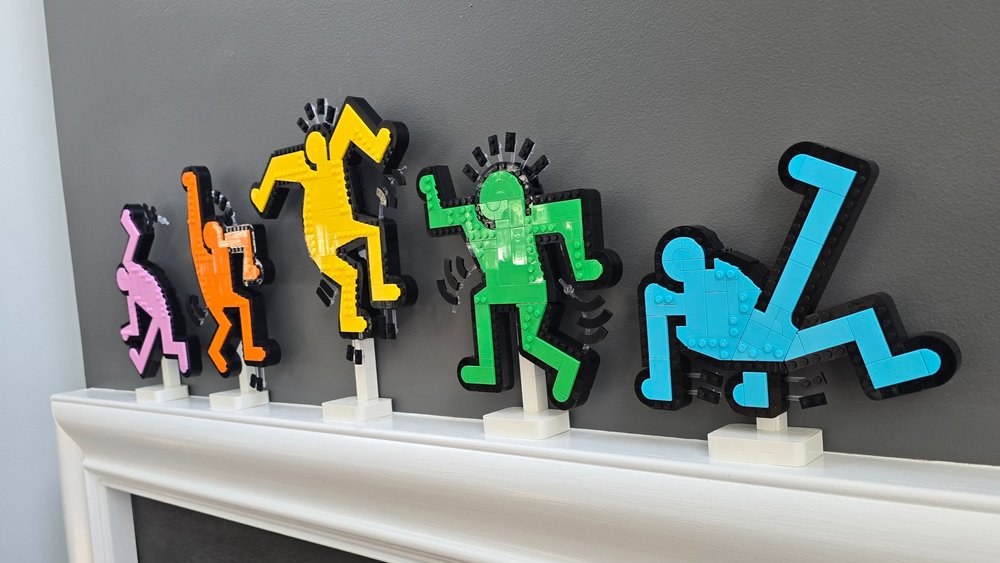
Part of me wishes LEGO would say it out loud. Say this set is an intentional nod to diversity, representation and inclusion of the queer community instead of being quiet and letting the set speak for itself. Say it honors Keith Haring not just as an artist, but as an activist—someone who used bold lines and bright colors to confront silence through movement. But for those who know Haring’s legacy, there’s no question.
Haring’s work never stood still. And neither should we.

LEGO Art 31216 Keith Haring - Dancing Figures will be available beginning May 15th for around US $120 | EU €120 | CA $150 | UK £105 | AU $200.
DISCLAIMER: This set was provided to BrickNerd by LEGO. Any opinions expressed in this article are those of the author.
Do you think these Dancing Figures are the successor to Everyone is Awesome? Let us know in the comments below!
Do you want to help BrickNerd continue publishing articles like this one? Become a top patron like Marc & Liz Puleo, Paige Mueller, Rob Klingberg from Brickstuff, John & Joshua Hanlon from Beyond the Brick, Megan Lum, Andy Price, Lukas Kurth from StoneWars, Wayne Tyler, Dan Church, and Roxanne Baxter to show your support, get early access, exclusive swag and more.